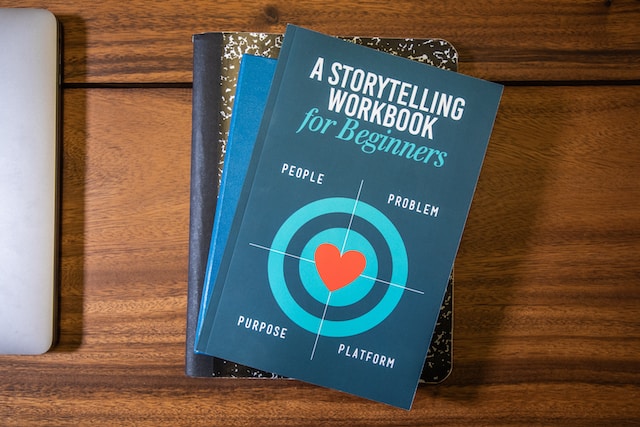Storytelling is one of the most powerful ways to communicate, persuade, and inspire. Stories capture our attention, engage our emotions, and shape our worldview. They help us make sense of the world and our place in it.
But storytelling is not just for entertainment. It’s also a vital skill for entrepreneurs and business owners who want to create a brand that people love. A brand that stands out, connects with customers, and drives sales.
In this blog post, I’ll share some tips and strategies on how to use story to create a brand that people love. I’ll show you how to:
- Focus your messaging on the customer’s story, not yours
- Position yourself as the guide, not the hero
- Create clear, simple soundbites
- Repeat your core message constantly across platforms
- Use story structure in your marketing messages
Focus on the Customer’s Story, Not Yours
The first mistake that many entrepreneurs and business owners make is to focus their messaging on their own story. They talk about their credentials, their achievements, their features, their benefits.
But here’s the thing: customers don’t care about your story. They care about their own story. They care about their problems, their desires, their goals, their fears.
Your job as a marketer is to enter the customer’s story and show them how you can help them. You need to empathize with their pain points and offer them a solution. You need to paint a vision of how their life will look better with your product or service.
Don’t be the hero in your brand’s story. Be the guide that helps the customer/hero win.
Position Yourself as the Guide, Not the Hero
This leads us to the second tip: position yourself as the guide, not the hero.
In every great story, there is a hero who wants something and faces a challenge. And there is a guide who helps them overcome that challenge and achieve their goal.
Think of Luke Skywalker and Obi-Wan Kenobi in Star Wars. Harry Potter and Dumbledore in Harry Potter. Frodo and Gandalf in Lord of the Rings.
The guide is not the main character of the story. The guide is there to support, mentor, and empower the hero. The guide provides wisdom, tools, and motivation.
In your brand’s story, your customer is the hero. They have a problem that they want to solve or a desire that they want to fulfill. And you are the guide who can help them do that.
Your role as the guide is to:
- Show empathy: demonstrate that you understand their situation and feelings
- Show authority: prove that you have the expertise and experience to help them
- Give a plan: provide a clear and simple process or framework for them to follow
- Call to action: urge them to take the next step with you
- Avoid failure: warn them of the risks or consequences of not taking action
- Promise success: show them the benefits or outcomes of taking action
By positioning yourself as the guide, not the hero, you build trust and credibility with your customers. You show them that you are not there to sell them something, but to help them achieve something.
Create Clear, Simple Soundbites
The third tip is to create clear, simple soundbites.
Soundbites are short, memorable phrases that capture your core message or value proposition. They are easy to understand, easy to remember, and easy to repeat.
Soundbites help you cut through the noise and clutter of today’s information overload. They help you communicate your brand’s essence in a way that sticks in people’s minds.
To create effective soundbites, you need to:
- Identify your customer’s problem: what is the main pain or challenge that they face?
- Explain your solution: how do you solve their problem or fulfill their desire?
- Describe the successful outcome: what is the result or benefit that they get from working with you?
For example, here are some soundbites from well-known brands:
- Apple: “Think different.”
- L’Oréal: “Because you’re worth it.”
- Mastercard: “There are some things money can’t buy. For everything else, there’s Mastercard.”
- Nike: “Just do it.”
Notice how these soundbites are succinct, focused on the customer’s pain points or aspirations, and make their solution sound new and understandable.
To create your own soundbite, try this formula:
[Problem] + [Solution] + [Outcome]
For example:
- “We help busy moms lose weight without dieting or deprivation.”
- “We teach aspiring writers how to publish their first book in 90 days.”
- “We design beautiful websites that attract more customers and increase sales.”
Once you have your soundbite, memorize it and repeat it constantly. Teach it to your team. Use it in your marketing materials, website copy, email signatures, etc. Repetition will brand it into people’s minds.
Repeat Your Core Message Constantly Across Platforms
The fourth tip is to repeat your core message constantly across platforms.
Your core message is the main idea or theme that you want your customers to remember about your brand. It’s the essence of your soundbite, but expanded into a longer statement.
Your core message should answer these questions:
- Who are you and what do you do?
- Who do you serve and what problem do you solve for them?
- How do you solve their problem and what makes you different from others?
- What is the successful outcome or benefit that they get from working with you?
For example, here’s a possible core message for a personal trainer:
“I’m John Smith, a certified personal trainer and nutrition coach. I help busy professionals lose weight, get fit, and feel great. I use a proven system that combines customized workouts, meal plans, and accountability coaching. Unlike other trainers, I don’t believe in one-size-fits-all programs or quick fixes. I help you create sustainable habits that fit your lifestyle and goals. By working with me, you’ll not only transform your body, but also your confidence, energy, and health.”
Your core message should be clear, concise, and compelling. It should highlight your unique value proposition and the transformation that you offer.
Once you have your core message, repeat it constantly across all platforms. Use it in your website homepage, social media bios, email newsletters, podcasts, videos, etc.
Repetition is key to branding. The more you repeat your core message, the more people will associate it with your brand. The more they will trust you, like you, and buy from you.
Use Story Structure in Your Marketing Messages
The fifth and final tip is to use story structure in your marketing messages.
Story structure is the framework or blueprint that every great story follows. It consists of:
- A character with a problem
- A guide who gives them a plan
- A call to action to avoid failure
- A climactic success
You can use this structure to craft compelling marketing messages that resonate with your customers and motivate them to take action.
Here’s how:
- Start by introducing the character (your customer) and their problem (their pain point or desire)
- Then introduce yourself as the guide who can help them solve their problem (your solution)
- Next, give them a plan to follow (your product or service)
- Then call them to action (your offer or invitation)
- Finally, show them the climactic success (the benefit or outcome) that they will achieve if they work with you
- And contrast it with the failure (the risk or consequence) that they will avoid if they don’t
For example, here’s a possible marketing message for a web design agency:
“Are you frustrated with your website? Does it look outdated, load slowly, or fail to convert visitors into customers? If so, you need a website makeover.
We’re Web Design Co., a team of expert web designers who can help you create a stunning website that attracts more customers and increases sales.
We use a proven process that involves:
- Understanding your goals and target audience
- Designing a custom website that reflects your brand and personality
- Optimizing your website for speed, performance, and SEO
- Testing and launching your website with minimal hassle
If you’re ready to take your website to the next level, contact us today for a free consultation and quote.
Don’t miss this opportunity to transform your online presence and grow your business.
If you don’t act now, you’ll continue to lose potential customers and revenue to your competitors who have better websites than yours.”
Notice how this message follows the story structure and creates an emotional connection with the customer. It also creates a sense of urgency and curiosity by using words like “frustrated”, “need”, “proven”, “ready”, “don’t miss”, “continue to lose”, etc.
By using story structure in your marketing messages, you can capture attention, build trust, overcome objections, and inspire action.
Can the StoryBrand Framework help you grow your business?
Storytelling is not just a nice-to-have skill for entrepreneurs and business owners. It’s a must-have skill for creating a brand that people love.
By applying these tips and strategies on how to use story to create a brand that people love, you can:
- Focus on the customer’s story, not yours
- Position yourself as the guide, not the hero
- Create clear, simple soundbites
- Repeat your core message constantly across platforms
- Use story structure in your marketing messages
By doing so, you’ll create a brand that stands out, connects with customers, and drives sales.
If you want to learn more about how to apply the StoryBrand Framework to your marketing, I highly recommend reading (or listening) to Building a StoryBrand: Clarify Your Message So Customers Will Listen by Donald Miller. It’s a great book that will teach you how to craft clear and compelling messages that resonate with your customers and drive them to action.
You can find the book on Amazon here:
https://amzn.to/43Mf1cC



